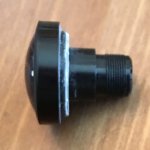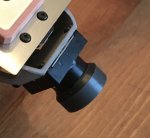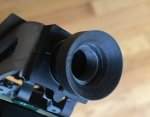Hello. I've looked at your drawing and what bits need making. The drawing are a good jod. I work 6 axis cnc machines. Making them would be easy. Is the build easy to do? Could knock the parts up over the week? What plastic? Was you thinking? Is there anything you would change like smaller pitch thread for focusing? Let me know? Could easy make some mods
Sorry for the delay. The plastic of choice is Delrin (acetal) of a dark color. Delrin is a really good machining plastic and is stable. If it is not dark, you should apply black paint to the end of the threaded adapter that faces the sensor.
You should cut back the camera barrel first, and then carefully measure the ID. Mine was a few thou out of round which made it easy to create a slight interference fit to the threaded adapter. Pay careful attention to how you fixture the camera. You want to get the end face of the camera barrel as parallel to the sensor as humanly possible. That said: no vice! Clamp it down to a horizontal plate. Also, cut a slug of clean, closed-cell foam to stick in the camera barrel to protect the sensor. I think I did a pretty good job of keeping the sensor clean, but I still went in with a swab and some alcohol, and gave it a careful wipe before I glued the adapter in place.
You'll need some 1mm X 3mm dowel pins for the spanner wrench. I got mine from McMaster-Carr. I found that a #60 drill created a nice, snug fit to the pins.
The o-ring is a -111 size. Mine happens to be Viton, but a standard Buna o-ring will work just fine. Again, McMaster-Carr. Remember to put a fine film of grease on the o-ring prior to assembly.
I chose JB-weld epoxy for assembly. Epoxy is not normally a good adhesive for hard plastic, but this particular one specifies plastic right on the pack. DO NOT USE CRAZY GLUE, SUPER GLUE, OR ANY OTHER INSTANT ADHESIVE! It will bloom, and permanently contaminate your optics!
To answer your question on thread pitch: I had no control over it, but yes, if I could, I would have gone finer.
No, in spite of my self-criticality, I can't think of anything I would change.
Please read my post from last Monday, the 8th.
-Lars










